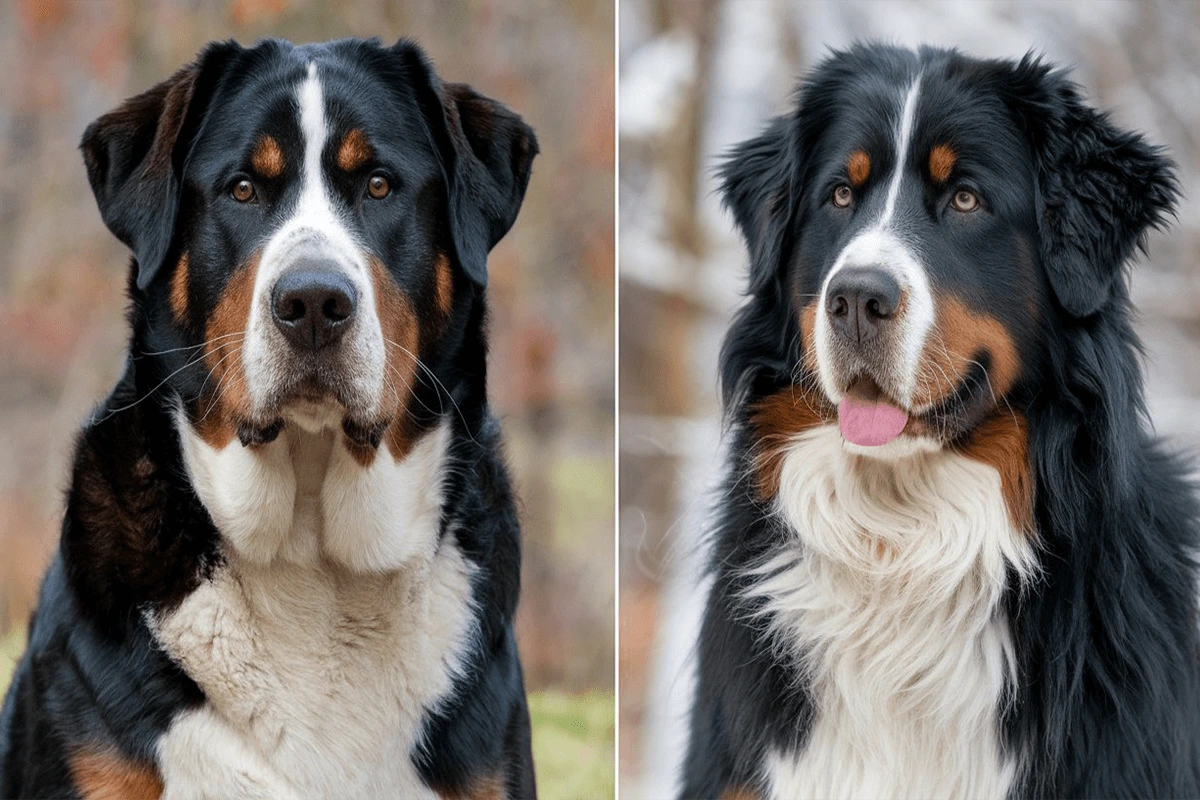The Greater Swiss Mountain Dog vs Bernese Mountain Dog debate is common among dog lovers looking for a large, loyal, and hardworking breed. Both dogs come from the Swiss Alps, where they worked as draft dogs, herding livestock and guarding farms. They share a rich history as working dog breeds, but key differences set them apart in size, temperament, grooming needs, and lifespan.
Choosing between these two family-friendly dog breeds depends on lifestyle, experience with large dogs, and the level of care an owner can provide. Some families prefer the Bernese Mountain Dog’s affectionate and easygoing nature, while others appreciate the Greater Swiss Mountain Dog’s confidence and protective instincts. This guide breaks down the top five key differences to help potential owners make the best choice.
Size and Build Comparison
When comparing the Greater Swiss Mountain Dog vs Bernese Mountain Dog, size and structure play a significant role in their differences. Both breeds originate from the Swiss Alps, where they worked as draft dogs, herders, and guardians. While they share the same tricolor coat pattern of black, white, and rust, their size, weight, and build set them apart. Understanding these differences helps potential owners determine which breed fits their lifestyle.
Physical Differences of the Greater Swiss Mountain Dog vs Bernese
At first glance, the Bernese Mountain Dog and the Greater Swiss Mountain Dog look alike because they both have a robust frame and a distinct tricolor coat. However, their coats differ in length and texture. The Bernese Mountain Dog has a thick, fluffy double coat that provides insulation in cold climates. This coat gives the Bernese a softer, more elegant appearance, but it also requires frequent grooming to prevent matting and excessive shedding.
In contrast, the Greater Swiss Mountain Dog has a short, dense coat that lies close to the body. While it still sheds year-round, the Swissy’s fur is easier to manage compared to the Bernese’s longer coat. This shorter coat highlights the Swissy’s muscular build, making it look more powerful and athletic. The Bernese, with its feathery fur and slightly longer frame, carries a softer and more relaxed posture.
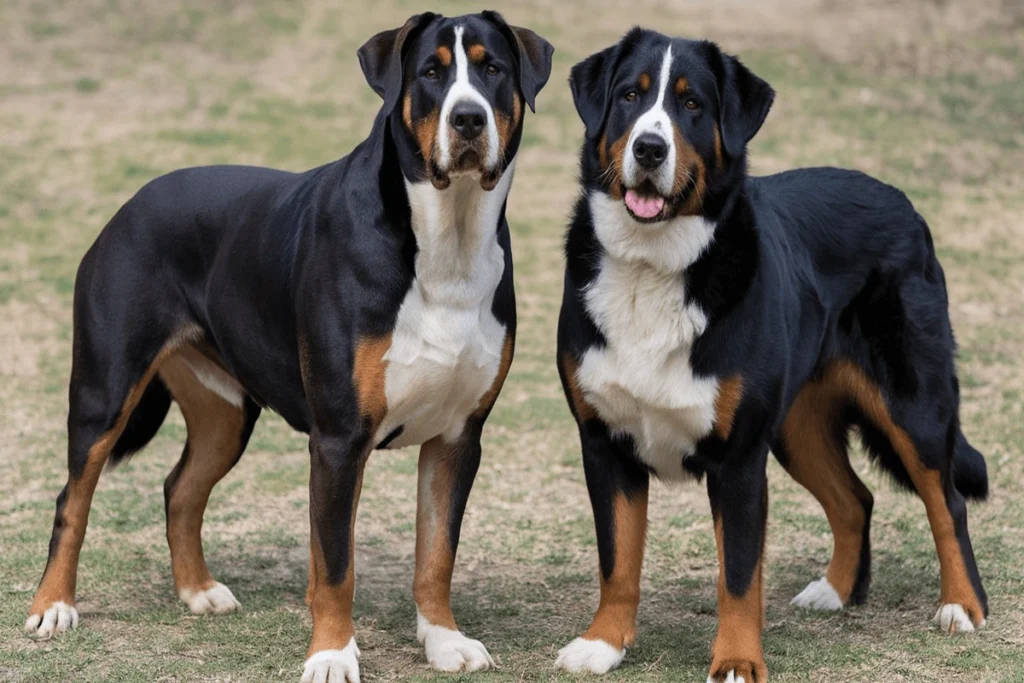
Weight and Height
One of the biggest differences between the Bernese Mountain Dog vs Swissy is their size and weight. The Greater Swiss Mountain Dog is generally taller, heavier, and more muscular than the Bernese Mountain Dog.
- Greater Swiss Mountain Dog Size:
- Males: 25.5 to 28.5 inches at the shoulder
- Females: 23.5 to 27 inches at the shoulder
- Weight: 85 to 140 pounds, with some males exceeding this range
- Bernese Mountain Dog Size:
- Males: 25 to 27.5 inches at the shoulder
- Females: 23 to 26 inches at the shoulder
- Weight: 70 to 115 pounds
The Swissy’s extra muscle mass and bone density give it a sturdier and more powerful build, making it well-suited for tasks that require endurance and strength. While the Bernese Mountain Dog is still a large and strong breed, it is slightly more compact and lighter.
Body Structure
The Greater Swiss Mountain Dog has a broad chest, straight back, and thick neck, which contributes to its rugged and athletic build. It was originally bred for heavy labor, such as pulling carts, hauling loads, and herding cattle. This physical strength allows the Swissy to excel in working roles that demand power and endurance. Its strong, muscular legs provide stability, making it less prone to joint issues compared to the Bernese.
The Bernese Mountain Dog, while still strong, has a longer and slightly more slender body. Its frame is built for agility rather than raw strength, making it better suited for tasks like herding livestock and moving through rough terrain. The Bernese has a gentler, more relaxed gait, while the Swissy moves with purposeful strength.
Another key structural difference lies in their tails and facial expressions. The Swissy has a thicker, slightly curved tail that emphasizes its stocky build, while the Bernese’s tail is bushier and often carried lower. Additionally, the Bernese has a softer expression due to its long fur and dark, expressive eyes, while the Swissy has a more alert and confident look.
Which Breed is Right for You?
If you prefer a powerful, muscular dog with endurance, the Greater Swiss Mountain Dog is the better choice. Its short coat requires less grooming, and its strong, athletic frame makes it ideal for owners who enjoy outdoor activities and training. However, if you want a gentle, affectionate, and slightly smaller dog with a softer appearance, the Bernese Mountain Dog is a great fit. Its fluffy double coat may require more maintenance, but its calm and friendly nature makes it a wonderful family companion.
By understanding these physical differences, potential owners can decide which breed aligns with their lifestyle and preferences.
Greater Swiss Mountain Dog vs Bernese Temperament and Personality
Temperament plays a crucial role in choosing between the Greater Swiss Mountain Dog vs Bernese Mountain Dog. Both breeds share loyalty, intelligence, and a strong work ethic, but their personalities differ in ways that affect training, socialization, and family life. While both excel as family-friendly dog breeds, they suit different types of owners and lifestyles.
Bernese Mountain Dog Temperament
The Bernese Mountain Dog is famous for its gentle, affectionate, and easygoing nature. Bernese dogs thrive on companionship and build strong emotional bonds with their families. They show deep devotion to their owners, often following them around the house and seeking attention. Because of their kind and patient temperament, Bernese Mountain Dogs do exceptionally well with children. They tolerate rough play and often become protective of young family members.
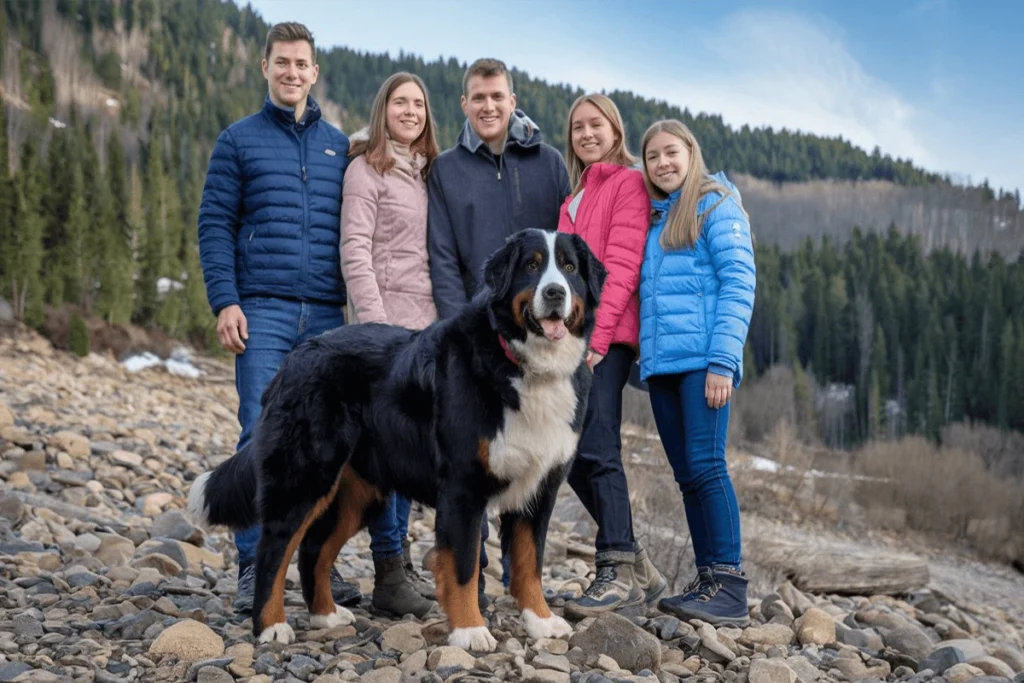
Despite their large size, Bernese dogs tend to be sensitive and gentle-hearted. They respond best to positive reinforcement training and may shut down if scolded too harshly. Bernese Mountain Dogs are also known for their friendly and social personality, making them great companions for families, individuals, and even first-time dog owners.
However, their affectionate nature comes with a downside—they dislike being left alone for long periods. If left without companionship, a Bernese can develop separation anxiety, leading to destructive behaviors like excessive barking or chewing. Because of their calm demeanor, they might not be the best choice for a guard dog, but they still alert their owners to potential dangers.
Greater Swiss Mountain Dog Traits
The Greater Swiss Mountain Dog has a more confident, bold, and protective personality compared to the Bernese. Bred to be a guardian and working dog, the Swissy remains alert, independent, and strong-willed. Unlike the Bernese, which tends to be more laid-back, the Swissy has a watchful and protective nature, making it an excellent watchdog.
Swissies form strong bonds with their families, but they do not show affection as openly as Bernese dogs. They enjoy companionship but remain more independent and self-reliant. Owners often describe them as loyal but not overly clingy. Because of their high intelligence and strong work ethic, they require consistent training and structure. Without proper leadership, a Swissy may try to assert dominance, making early socialization and obedience training essential.
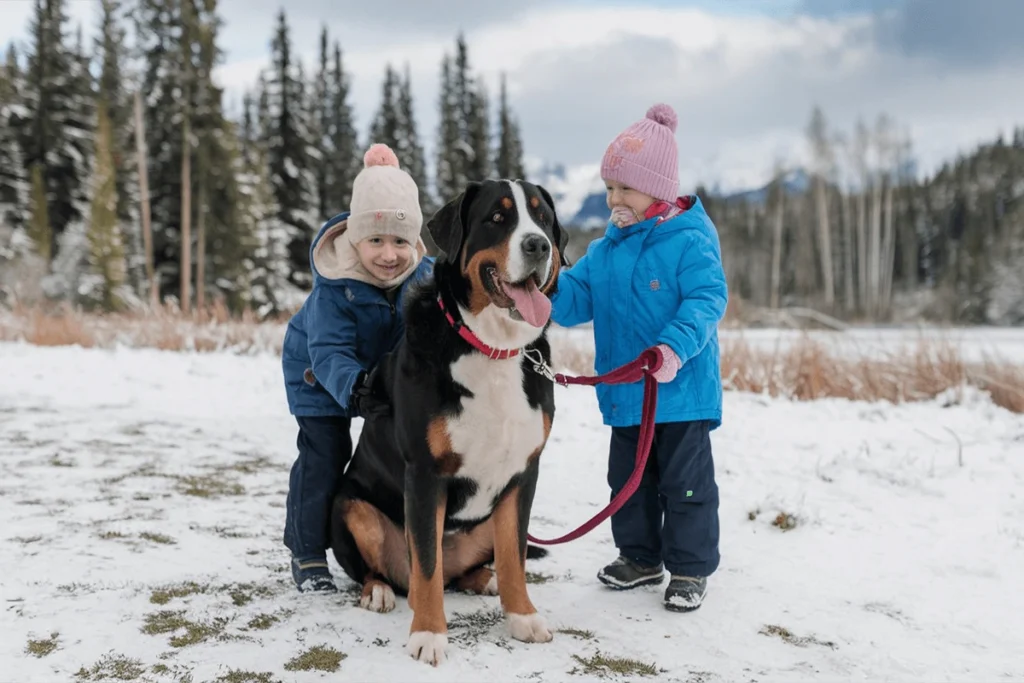
While the Greater Swiss Mountain Dog is good with children, it tends to be more energetic and boisterous than the Bernese. Its playful yet strong personality means it can accidentally knock over small children, so supervision is recommended. Unlike the Bernese, which thrives on constant affection, the Swissy enjoys having a job to do, whether it’s pulling a cart, hiking, or engaging in dog sports.
Since Swissies are natural problem-solvers, they sometimes test their boundaries with stubborn behavior. They do well with experienced owners who understand firm, consistent training techniques. While they love their families, they do not suffer from separation anxiety as often as Bernese dogs, making them a better choice for owners who work long hours.
Best Family Dog: Greater Swiss Mountain Dog vs Bernese?
Both breeds make wonderful family companions, but choosing between them depends on the owner’s lifestyle and expectations.
- Best for affectionate, easygoing families → The Bernese Mountain Dog wins for families who want a gentle, loving, and social dog that thrives on attention. If you have young children or want a cuddly companion, the Bernese is the perfect fit. However, they require frequent interaction and can struggle with being left alone.
- Best for active, experienced owners → The Greater Swiss Mountain Dog is ideal for owners looking for a confident, protective, and independent working dog. If you want a large breed that serves as both a watchdog and family pet, the Swissy is the better choice. However, they need structured training and plenty of physical and mental stimulation.
If your family prefers a calm, affectionate, and gentle giant, the Bernese Mountain Dog is the best option. If you want a strong, independent, and alert companion who enjoys physical activity and has protective instincts, the Greater Swiss Mountain Dog is the better match.
By understanding these key temperament differences, potential owners can choose the breed that best suits their family, lifestyle, and level of experience.
Shedding and Grooming Needs
Both the Greater Swiss Mountain Dog and the Bernese Mountain Dog have thick coats that shed, but they differ in coat length, grooming needs, and shedding patterns. Owners who prefer a low-maintenance coat may favor the Swissy, while those who don’t mind extra brushing might enjoy the Bernese’s fluffy coat. Understanding their shedding habits and grooming requirements helps potential owners prepare for proper coat care and maintenance.
Greater Swiss Mountain Dog vs Bernese Shedding
The Bernese Mountain Dog has a long, thick double coat, which sheds heavily year-round. This breed experiences two major shedding seasons—typically in the spring and fall—when it blows its coat to adjust for seasonal temperature changes. During these periods, Bernese owners notice large amounts of fur on furniture, clothing, and floors.
In contrast, the Greater Swiss Mountain Dog has a shorter, dense double coat that also sheds consistently but appears less noticeable. The Swissy’s fur doesn’t mat as easily as the Bernese’s, and it doesn’t require as much maintenance. However, because of its shorter, coarse hairs, Swissy fur tends to stick to fabrics like upholstery and carpets. Owners may not see large tufts of fur around the house, but they will find embedded hair on clothing and furniture.
While both breeds shed throughout the year, the Bernese Mountain Dog requires significantly more grooming and cleaning to manage its heavier shedding.
Grooming Requirements
The Bernese Mountain Dog demands regular brushing to prevent matting, tangles, and excessive loose fur. Owners should brush a Bernese at least 3 to 4 times per week, with daily brushing recommended during peak shedding seasons. Using a slicker brush, undercoat rake, and deshedding tool helps remove loose hair and reduce shedding indoors.
Because of their long fur, Bernese Mountain Dogs are prone to dirt, debris, and moisture buildup, which can cause skin irritation or hot spots if not properly maintained. Bathing should happen every 6 to 8 weeks, but owners may need to wipe down the coat or spot-clean dirt-prone areas more frequently.
The Greater Swiss Mountain Dog, on the other hand, requires much less grooming due to its shorter coat. Brushing just once or twice a week with a rubber curry brush or bristle brush helps remove loose fur and distribute natural oils. Unlike the Bernese, the Swissy does not develop tangled fur or mats, making grooming a quicker and easier task.
Bathing should occur every 8 to 12 weeks, as Swissies naturally stay cleaner and don’t trap as much dirt in their coat. While they shed consistently, their short fur does not clump together or get tangled, reducing the need for frequent grooming.
Despite their differences in coat length, both breeds need regular nail trimming, ear cleaning, and dental care to stay healthy.
Seasonal Shedding
Both the Bernese Mountain Dog and the Greater Swiss Mountain Dog experience seasonal shedding, though the Bernese sheds more heavily during these times.
- Bernese Mountain Dog Seasonal Shedding:
- Sheds the most in spring and fall when the coat transitions between warm and cold seasons
- Loses a significant amount of undercoat, requiring daily brushing during peak shedding periods
- Shed fur sticks to furniture and clothing, requiring frequent vacuuming and lint rolling
- Greater Swiss Mountain Dog Seasonal Shedding:
- Also sheds more in spring and fall, but not as dramatically as the Bernese
- Coat remains easier to manage, with less visible fur accumulation around the house
- Benefits from more frequent brushing during seasonal coat changes, but still requires less maintenance than the Bernese
Both breeds require consistent grooming routines, but the Bernese Mountain Dog’s long double coat makes it a higher-maintenance breed. The Greater Swiss Mountain Dog sheds year-round, but with less visible fur and lower grooming demands.
Which Breed is Easier to Maintain?
- Best for owners who don’t mind regular grooming → The Bernese Mountain Dog is the better choice for those who enjoy brushing and maintaining a thick, fluffy coat. Owners must manage heavy shedding and expect to clean up fur frequently.
- Best for owners who want a low-maintenance coat → The Greater Swiss Mountain Dog is ideal for those who prefer less grooming and easier coat maintenance. While Swissies still shed, they require less frequent brushing and don’t leave behind as much noticeable fur.
By understanding shedding patterns and grooming needs, owners can decide whether they prefer the fluffy, high-maintenance Bernese or the short-haired, lower-maintenance Swissy.
Lifespan and Health Considerations
When comparing the Greater Swiss Mountain Dog vs Bernese Mountain Dog, lifespan and health play a crucial role in choosing the right breed. Both breeds descend from Swiss working dog breeds and share Molosser ancestry, but their lifespan, common health issues, and care requirements differ. The Greater Swiss Mountain Dog typically lives longer and experiences fewer genetic health problems, while the Bernese Mountain Dog has a shorter lifespan due to a higher risk of serious illnesses. Proper care, a healthy diet, and regular exercise help both breeds live long and fulfilling lives.
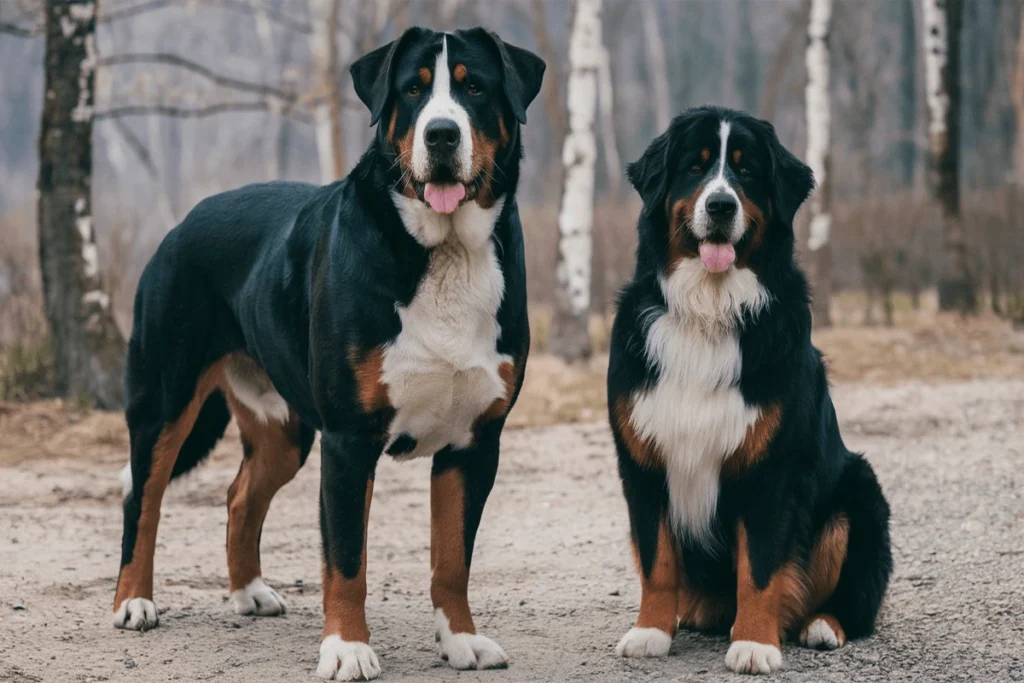
Greater Swiss Mountain Dog vs Bernese Lifespan
The Greater Swiss Mountain Dog generally lives longer than the Bernese Mountain Dog, making it a more appealing choice for owners looking for a long-term companion.
- Greater Swiss Mountain Dog Lifespan: 10 to 12 years
- Bernese Mountain Dog Lifespan: 6 to 8 years
The Bernese Mountain Dog has one of the shortest lifespans among large breeds. Many Bernese dogs develop genetic disorders, cancers, or joint issues that shorten their lives. In contrast, the Greater Swiss Mountain Dog remains healthier overall, with fewer cases of hereditary diseases.
While both breeds face age-related health challenges, the Swissy’s longer lifespan makes it a better option for families who want a large breed with more years of companionship.
Common Health Issues
Both the Bernese Mountain Dog and Greater Swiss Mountain Dog are prone to certain health problems due to their large size and working dog heritage. However, the Bernese Mountain Dog has a higher risk of genetic diseases, while the Greater Swiss Mountain Dog remains sturdier and healthier on average.
- Greater Swiss Mountain Dog Health Issues:
- Hip and elbow dysplasia – A common issue in large breeds, leading to joint pain and mobility problems.
- Bloat (Gastric Torsion) – A life-threatening condition where the stomach twists and traps gas, requiring immediate medical attention.
- Splenic torsion – A rare but serious condition where the spleen twists and cuts off blood flow.
- Lick fits – A behavior where Swissies lick excessively due to nausea or digestive upset, often related to diet.
- Bernese Mountain Dog Health Issues:
- Cancer (Histiocytic Sarcoma, Lymphoma, Osteosarcoma) – A major cause of early death in Bernese dogs.
- Hip and elbow dysplasia – Common in large breeds and worsened by excess weight or improper exercise.
- Degenerative myelopathy – A progressive nerve disease that leads to paralysis in older dogs.
- Heart disease – Some Bernese Mountain Dogs develop heart issues like subaortic stenosis (SAS), affecting blood flow.
Because of their high cancer rate, Bernese owners must schedule regular vet checkups and watch for early signs of illness. The Greater Swiss Mountain Dog has fewer genetic disorders, but owners still need to monitor joint health and prevent bloat through proper feeding and exercise routines.
Exercise and Diet Needs
Both the Greater Swiss Mountain Dog and Bernese Mountain Dog require daily exercise and a balanced diet to maintain their health. However, their activity levels and metabolism differ.
- Greater Swiss Mountain Dog Exercise Needs:
- Requires moderate daily exercise (30 to 60 minutes) to stay fit and prevent obesity.
- Enjoys structured activities like hiking, cart pulling, and obedience training.
- Has high endurance but does not need excessive exercise like a herding breed.
- Can become bored or stubborn if not mentally stimulated.
- Bernese Mountain Dog Exercise Needs:
- Needs moderate exercise (45 to 60 minutes daily) but has lower endurance than the Swissy.
- Prefers gentle activities like walking, playing, or short hikes instead of intense workouts.
- Prone to overheating due to thick fur, so outdoor exercise should happen in cooler parts of the day.
- Benefits from low-impact exercise to protect joints and prevent early arthritis.
Both breeds require controlled activity while growing since excessive exercise can harm developing joints.
Diet Needs
A nutritious diet plays a key role in keeping both the Bernese Mountain Dog and Greater Swiss Mountain Dog healthy. Large breeds need high-quality protein, balanced fats, and joint-supporting nutrients to maintain strong bones and muscles.
- Greater Swiss Mountain Dog Diet:
- Needs high-protein, moderate-fat meals to sustain its muscular build.
- Benefits from glucosamine and chondroitin to support joint health.
- Requires slow feeding methods (like puzzle bowls) to prevent bloat.
- Should avoid overfeeding, as Swissies gain weight easily.
- Bernese Mountain Dog Diet:
- Requires high-quality protein with omega fatty acids to maintain a healthy coat.
- Needs calcium and phosphorus to support growing bones and joints.
- Prone to bloat, so feeding smaller, frequent meals helps digestion.
- Should eat a well-balanced, vet-approved diet to reduce cancer risk.
By providing proper nutrition and exercise, owners can help extend the lifespan and overall health of both breeds.
Which Breed is Healthier and Easier to Care For?
- Best for owners who want a longer lifespan and fewer health issues → The Greater Swiss Mountain Dog is the better choice due to its longer life expectancy and lower risk of genetic diseases.
- Best for owners who don’t mind extra veterinary care → The Bernese Mountain Dog is a wonderful, affectionate breed but requires more medical attention and a commitment to regular health screenings.
Both breeds need proper exercise, a nutritious diet, and regular veterinary care, but the Greater Swiss Mountain Dog has fewer health risks and lives longer, making it a better option for owners looking for a healthier, long-term companion.
Greater Swiss Mountain Dog vs Bernese Purpose and Trainability
Breed History and Recognition
Both the Greater Swiss Mountain Dog and Bernese Mountain Dog have deep roots in Switzerland’s working dog heritage. As draft dogs and livestock guardians, they played essential roles in Swiss farms and mountain regions, helping farmers pull carts, herd cattle, and guard property. Despite their similarities, their working styles, guarding instincts, and breed recognition differ. Understanding their backgrounds helps potential owners appreciate the unique characteristics of each breed.
Draft Dogs and Working Background
The Greater Swiss Mountain Dog vs Bernese Mountain Dog belong to the Molosser group, a lineage of large, powerful working dogs bred for strength, endurance, and versatility. Both breeds evolved in the Swiss Alps, where they assisted farmers with various tasks.
- Greater Swiss Mountain Dog Working Background:
- Developed as a draft dog, capable of pulling heavy loads across rugged terrain.
- Used primarily for hauling milk, cheese, and other farm goods in carts.
- Excelled at guarding livestock and homes, often serving as a deterrent to predators and intruders.
- Known for exceptional stamina and work ethic, making it a valuable farm companion.
- Bernese Mountain Dog Working Background:
- Served as an all-purpose farm dog, handling herding, cart pulling, and guarding duties.
- Less muscular than the Swissy but strong enough to pull light carts and assist with farm labor.
- Preferred for herding cattle due to its gentle temperament and intelligence.
- Adapted well to family life, becoming more of a companion dog over time.
Although both breeds excelled as working dogs, the Greater Swiss Mountain Dog remained a true draft and guard dog, while the Bernese Mountain Dog developed into a more social, family-oriented breed.
Herding and Guarding Dogs
While both breeds have herding and guarding instincts, their protective nature and working styles set them apart.
- Greater Swiss Mountain Dog as a Guarding Breed:
- Naturally alert and watchful, making it an excellent watchdog.
- Displays strong territorial instincts, often barking at unfamiliar people or animals.
- Not aggressive but cautious around strangers, requiring proper socialization.
- Confident and independent, capable of making decisions in guarding situations.
- Bernese Mountain Dog as a Herding Breed:
- More gentle and welcoming, often friendly toward strangers.
- Protective of family but less territorial than the Swissy.
- Herding background makes it responsive to commands, especially in guiding livestock.
- Prefers staying close to its owners, thriving on human companionship.
The Greater Swiss Mountain Dog makes a better natural protector, while the Bernese Mountain Dog focuses more on family and herding duties. Families looking for a gentle, affectionate companion may prefer the Bernese, while those wanting a protective yet loving watchdog may find the Swissy more suitable.
AKC Recognition and Popularity of the Greater Swiss Mountain Dog vs Bernese
The American Kennel Club (AKC) recognizes both the Greater Swiss Mountain Dog and Bernese Mountain Dog as part of the Working Group. However, their popularity and recognition differ due to their unique traits.
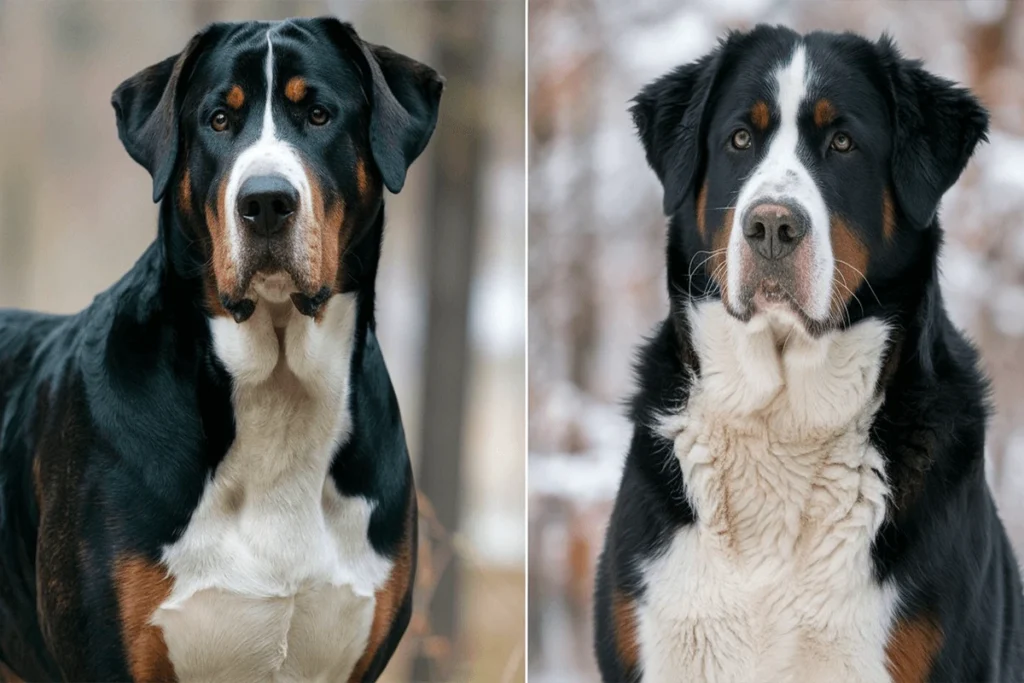
- Bernese Mountain Dog Popularity:
- Officially recognized by the AKC in 1937.
- Ranked among the top 25 most popular dog breeds in the U.S. due to its gentle temperament and family-friendly nature.
- Frequently seen in dog shows, therapy work, and obedience training.
- More well-known than the Swissy, thanks to its friendly personality and striking appearance.
- Greater Swiss Mountain Dog Popularity:
- Recognized by the AKC in 1995, making it a relatively newer breed in the U.S..
- Less common than the Bernese but growing in popularity among owners seeking a strong, protective working dog.
- Appreciated by experienced owners and working dog enthusiasts, rather than first-time dog owners.
- Often used in cart-pulling competitions, search and rescue, and farm work.
While the Bernese Mountain Dog enjoys greater popularity worldwide, the Greater Swiss Mountain Dog continues to gain recognition for its working ability and versatility.
Which Breed Suits Different Lifestyles?
- Best for a family-friendly, affectionate companion → The Bernese Mountain Dog is ideal for those who want a gentle, friendly, and loving breed that thrives on human interaction.
- Best for a strong, protective working dog → The Greater Swiss Mountain Dog fits owners looking for a loyal guardian, draft dog, and independent thinker.
Both breeds share a rich working history, but the Bernese Mountain Dog thrives as a companion dog, while the Greater Swiss Mountain Dog maintains its strong working instincts. Choosing between them depends on whether owners prefer a gentle herding breed or a watchful draft and guard dog.
Conclusion
Choosing between the Greater Swiss Mountain Dog vs Bernese Mountain Dog depends on lifestyle, experience, and preferences. Both breeds share a rich history as Swiss working dogs, but they differ in temperament, grooming needs, health, and working instincts.
The Bernese Mountain Dog stands out as a gentle, affectionate, and family-friendly breed. It thrives in homes that provide companionship, moderate exercise, and consistent grooming. Families looking for a loving, friendly dog that bonds deeply with its owners will appreciate the Bernese’s loyal and affectionate nature. However, owners must prepare for heavy shedding, shorter lifespan, and potential health concerns like cancer and joint issues.
On the other hand, the Greater Swiss Mountain Dog offers strength, endurance, and a natural guarding instinct. It suits experienced owners who want a protective yet affectionate working dog. The Swissy requires less grooming than the Bernese but benefits from consistent training, mental stimulation, and regular exercise to prevent boredom. With a longer lifespan and fewer genetic health issues, the Greater Swiss Mountain Dog is an excellent choice for those seeking a low-maintenance yet hardworking companion.
When comparing the Greater Swiss Mountain Dog vs Bernese, both breeds bring unique qualities to a household. The Bernese Mountain Dog fits families looking for an affectionate companion, while the Greater Swiss Mountain Dog appeals to those wanting a strong, confident, and protective working dog. Understanding their key differences in temperament, lifespan, shedding, and working background helps potential owners make the best choice. Whether choosing the gentle Bernese or the sturdy Swissy, both breeds provide unwavering loyalty and companionship to the right home.
You Can Read More About The Greater Swiss Mountain Dog Here.
Learn More about The Other Giant Dog”Bernese Mountain Dog“
Discover All kind of Dog Breeds From Here
Find The Best Stuff For your Pet on PetMD Official.
